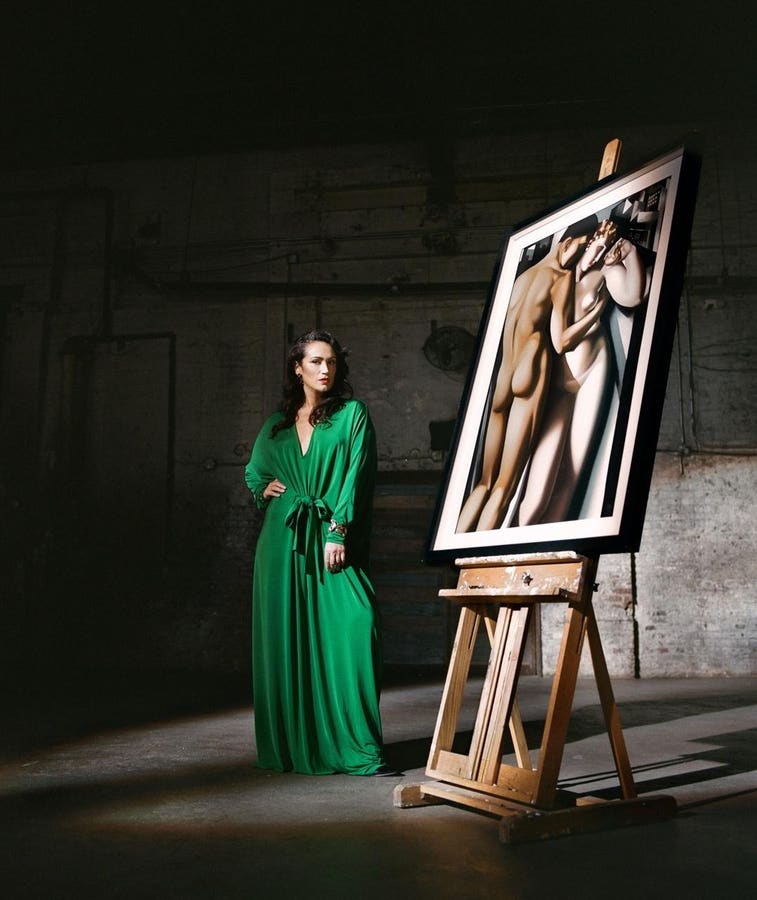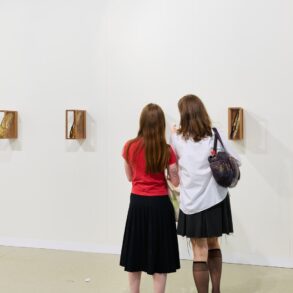
The new Broadway musical Lempicka celebrates the life of Polish artist Tamara de Lempicka. The outspoken painter was known for her daring art deco portraits. She had a storied life that seemed unacceptable for a woman at the time. Considered a radical, Lempicka was a survivor of the Bolshevik Revolution and the Nazis. While she was married and she had affairs with women and men.
Yet unlike her male contemporaries this iconoclast who lived without apology has often been written out of history. “She was someone who the world wanted to hide and tried to kill multiple times,’ says Lempicka’s director Rachel Chavkin. “She lived this incredibly violent and ambitious life.”
16 years ago when playwright and lyricist Carson Kreitzer discovered a Taschen art book about Lempicka in a used book store, she knew she had the ultimate material for a musical. “I had no idea about her intense and difficult life—what it took to become that artist and what was behind these dramatic, decadent figures,” she says.
And then there were Lempicka’s paintings that seemed so arresting to Kreitzer. “Her female nudes often reference classical paintings from the long tradition of men painting naked women,” says Kreitzer. “But her observation of the body is so lush, so sensual, you can really feel her appreciation for that body, her desire.”
Kreitzer wished she had learned about Lempicka when she was growing up. “She was a woman of incredible vision. She had the kind of appetite that is often considered monstrous in a woman,” she says.
Early in her life Lempicka was forced to flee Poland, was a refugee in Paris and managed to carve out a career as an artist. And through it all her unique angular painting style managed to be sensual and move people.
“One of the things I love most about her story is that only by losing everything she had, did she become the painter she was meant to be,” says Kreitzer. “If not for the Russian Revolution, and the total upheaval of her world, she would not have invented herself, and we would not have the work she spent her life creating.”
A bisexual woman Kreitzer also fiercely connected with Lempicka. “Tamara loved her husband, but carried on affairs with women and men, and felt that it was her right to do so. I just freaking loved that,” says Kreitzer. “All she was asking for was what every male artist ever has taken for granted—a wife and a mistress. So there was family life at home and a muse, or collection of muses, in the studio.”
After discovering Lempicka Kreitzer met composer Matt Gould at the New Dramatists Composer-Librettist Studio. The program matches writers with composers as they collaborate on musical theater. After writing one song together they felt an instant bond.
Amber Iman and Eden Espinosa in a scene from Lempicka
“We were so different in some ways, but very similar in our intensity, the way we threw ourselves into the work. And also into tremendous laughter,” says Kreitzer. “Cracking up Matt is still one of my favorite things to do. And we also collaborate on this incredibly intense, deeply emotional material.” As Gould sees it Carson is the brains and detail in their collaboration. “I am passion, soaring and big picture,” he says.
The last day of their workshop Kreitzer met Gould at a diner and slid her Lempicka art book towards him across the table. Kreitzer asked, “Do you want to do a show?”
They began writing their epic musical with Gould composing music and Kreitzer penning the lyrics. The duo co-wrote the book together. With time their passion for Tamara de Lempicka and her paintings only deepened. They felt even stronger that Lempicka’s life would be so ideal for a musical. As Gould says great art often comes from people who have been oppressed.
“There’s something about the perfectly glowing curation of the bodies in conversation with a fear/terror/passion behind the eyes of the people. It was that juxtaposition that felt so obviously like it would lend itself to musical theater,” says Gould about Lempicka’s paintings. He saw the rage of her subjects trapped within their beautiful veneer.
“For me juxtaposition and tension are what makes a song in the theater,” says Gould. “There is the thing we say that we feel to the people around us, and then the thing we ACTUALLY feel on the inside. The “actual” feeling is the part that MUST sing.”
Natalie Joy Johnson, (in gold dress) and the cast of Lempicka
They hoped someday, maybe, the show would get to Broadway. “But in the back of our minds, we thought no one will ever produce a musical about a bisexual jewish female painter whose name no one can pronounce,” says Gould.
Despite their secret doubts this past month Lempicka opened on Broadway at the Longacre Theatre. The cast features Amber Iman, Andrew Samonsky, George Abud, Natalie Joy Johnson, Zoe Glick, Nathaniel Stampley, Beth Leavel and Eden Espinosa, who plays Tamara de Lempicka.
Director Rachel Chavkin and choreographer Raja Feather Kelly share the belief that the show is by no means a conventional biopic. “I believe it’s important for audiences to know that,” says Chavkin. “It offers the fusion of fashion, music videos and throbbing contemporary hunger at its heart while also having this glorious epic sweep.”
Chavkin sometimes half jokingly calls the show “Les Miz.” She sees that kind of ambition present in its form. “But Raja and I are also downtown kids,” she says. “So it’s always through the lens of experimentation and question.” For Kelly the show has contemporary reflections. “It asks how does what we learn about Tamara reflect in our own lives,” he says.
Lempicka’s cast features Amber Iman, Andrew Samonsky, George Abud, Natalie Joy Johnson, Zoe Glick, Nathaniel Stampley, Beth Leavel and Eden Espinosa who plays Tamara de Lempicka. From the moment Espinosa joined the production in 2018 she was deeply invested in Lempicka’s story.
“There was always something about this show and role that made me feel so much. It made me feel for her and have compassion and an interest in her,” says Espinosa. “I would see a concert version or reading, I saw how I would play her in my mind. And that feeling is like a magnet pulling you to a piece, that I just knew, I had to be a part of this.” She was convinced that one day she would. “I didn’t know how but I hoped, and I knew somehow, it would happen.”
After all he’s learned about her if Gould could say anything to Lempicka he would first say “Thank you,” he says. “For your courage. For your willingness to show a world that wanted to annihilate your sex, your sexuality, your profession, your religion. Thank you for your willingness to risk everything to capture a moment in time that would shockingly and predictably capture THIS moment in time.”
And what does Kritzer hope people take away from the show? “I hope people let her challenge them the way she has challenged me all these years of working on it,” she says. “To live more bravely. To not accept the smaller life that would make everyone else more comfortable. And it may be hard and people will push back, but you have the right to be the protagonist in your own life.”
(From left) Matt Gould and Carson Kreitzer at Lempicka’s opening night
Beth Leavel in a scene from Lempicka
Nu Adossé, one of several Lempicka prints hanging outside the Longacre Theatre. “There is nothing … [+]
This post was originally published on this site be sure to check out more of their content








